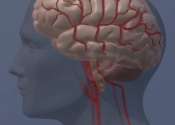An antipsychotic (or neuroleptic) is a tranquilizing psychiatric medication primarily used to manage psychosis (including delusions or hallucinations, as well as disordered thought), particularly in schizophrenia and bipolar disorder. A first generation of antipsychotics, known as typical antipsychotics, was discovered in the 1950s. Most of the drugs in the second generation, known as atypical antipsychotics, have been developed more recently, although the first atypical antipsychotic, clozapine, was discovered in the 1950s and introduced clinically in the 1970s. Both generations of medication tend to block receptors in the brain's dopamine pathways, but antipsychotic drugs encompass a wide range of receptor targets.
A number of harmful and undesired (adverse) effects have been observed, including lowered life expectancy, weight gain, decrease in brain volume, enlarged breasts and milk discharge in men and women (hyperprolactinaemia), lowered white blood cell count (agranulocytosis), involuntary repetitive body movements (tardive dyskinesia), diabetes, an inability to sit still or remain motionless (akathisia), sexual dysfunction, a return of psychosis requiring increasing the dosage due to cells producing more neurochemicals to compensate for the drugs (tardive psychosis), and a potential for permanent chemical dependence leading to psychosis much worse than before treatment began, if the drug dosage is ever lowered or stopped (tardive dysphrenia).[citation needed]
Temporary withdrawal symptoms including insomnia, agitation, psychosis, and motor disorders may occur during dosage reduction of antipsychotics, and can be mistaken for a return of the underlying condition.
The development of new antipsychotics with fewer of these adverse effects and with greater relative effectiveness as compared to existing antipsychotics (efficacy), is an ongoing field of research.









